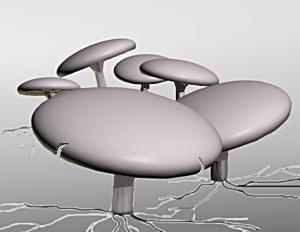BY LETTER
Mushrooms
 Image from Steve Bowers | |
| The visible parts of the mushroom are the fruiting bodies of the organism, attached to a network of hyphae, generally hidden below ground | |
A mushroom is the large fleshy fruiting body produced by some varieties of Terragen fungi. The word is also used for analogous non-Terragen biological forms, or even for some kinds of hylonano sporetech devices (forms of nanorot) that function in comparable ways. Like trees, mushrooms are a common morphotype and have arisen many times by convergence, not only among various lineages on Old Earth but elsewhere as well; the biota of Tou'l'h Prime provide a particularly good example of this phenomenon. The term "mushroom" is most often used for structures of the familiar parasol form with a stem and cap, but may refer to shelf-like, coralline, spherical, or other shapes as well. The mushroom is a specialized structure for spore dispersal in an atmosphere, and typically represents the visible fraction of a much more extensive and massive organism that grows as a network of threadlike structures dispersed through a growth medium. Terragen fungal species were gathered and used as foods, dyes, and pharmaceuticals by human baselines since before the dawn of civilization, and some have been in domestic cultivation since the Agricultural Age. These and their gengineered descendants have been a part of Terragen civilization ever since.
In the first flush of true gengineering towards the end of the 1st century AT, many Terragen species of traditional edible mushrooms were modified to make them easier to cultivate: capable of fruiting on a predictable schedule or according to set environmental cues, and able to live on a wide variety of readily available substrates. Many baseline species that were originally symbionts or parasites on tree roots were altered so that they could grow directly from non-living organic material or on the roots of existing crop plants. In this way, previously rare and valuable "wild" fungi such as baseline boletes, chanterelles, truffles, matsutake, morels, edible puffballs, and many others became as common and easy to raise as more typical domestic species had been. As for the earlier cultivated mushrooms such as the baseline portobello, oyster, straw, shiitake, and common button mushrooms, the new versions were even easier to grow, and were modified to feed on waste straw or wood, aged manures, or other readily available organic materials including carefully treated sewage or garbage. With this increase in availability, and given the increasing attention to tight energy and nutrient cycling during this period both on Old Earth because of a need to minimize environmental impacts and elsewhere in Solsys as a simple necessity in closed systems they became more common as a food item, especially in cultures that already had a tradition of eating fungi.
There were also specialty varieties aside from those created with nutrition in mind. Dyes and other chemicals could be inexpensively produced in this way from materials that might otherwise have gone to waste. Pharmaceuticals (particularly antibacterials, or psychotropic drugs such as psilocybin and muscimol) were common as well. The notorious anti-alcoholic "safeshrooms" date from this early period. In a few cases new flavourings and spices were created; one of the more notable was a version of the "peppery" bolete, which took its place in Terragen cuisine alongside such sources as chilies, black pepper, wasabi, and fagara as a source of "heat" in foods cherished by humans and other omnivorous mammalian vertebrates. A later generation of more fundamental gengineering led to the meatshrooms. Mushrooms remain an important element in the economies, ecosystems, and diets of many bionts. Even residents on megastructures or fully terraformed worlds, where recycling of materials on a local scale is not an issue, often cultivate them simply because of the number of tasty or useful varieties. Likewise those who for cultural or philosophical reasons derive all their nutrition directly from a food-grade nanofac may still call up facsimiles of the original products.
Related Articles
- Fungi (Mycophyta) - Text by M. Alan Kazlev
Free-living or nutrient absorptive terragen eukaryotes with chitinous cell walls characterized by hyphae (small branched filaments) and propagating through spores. Includes the yeasts, mushrooms, and molds. Over 60,000 baseline terragen species, many more developed since. There are equivalent fungi-like organisms in many garden worlds. - Meatshrooms
- Safeshrooms
Appears in Topics
Development Notes
Text by Stephen Inniss
Initially published on 21 January 2009.
Initially published on 21 January 2009.






